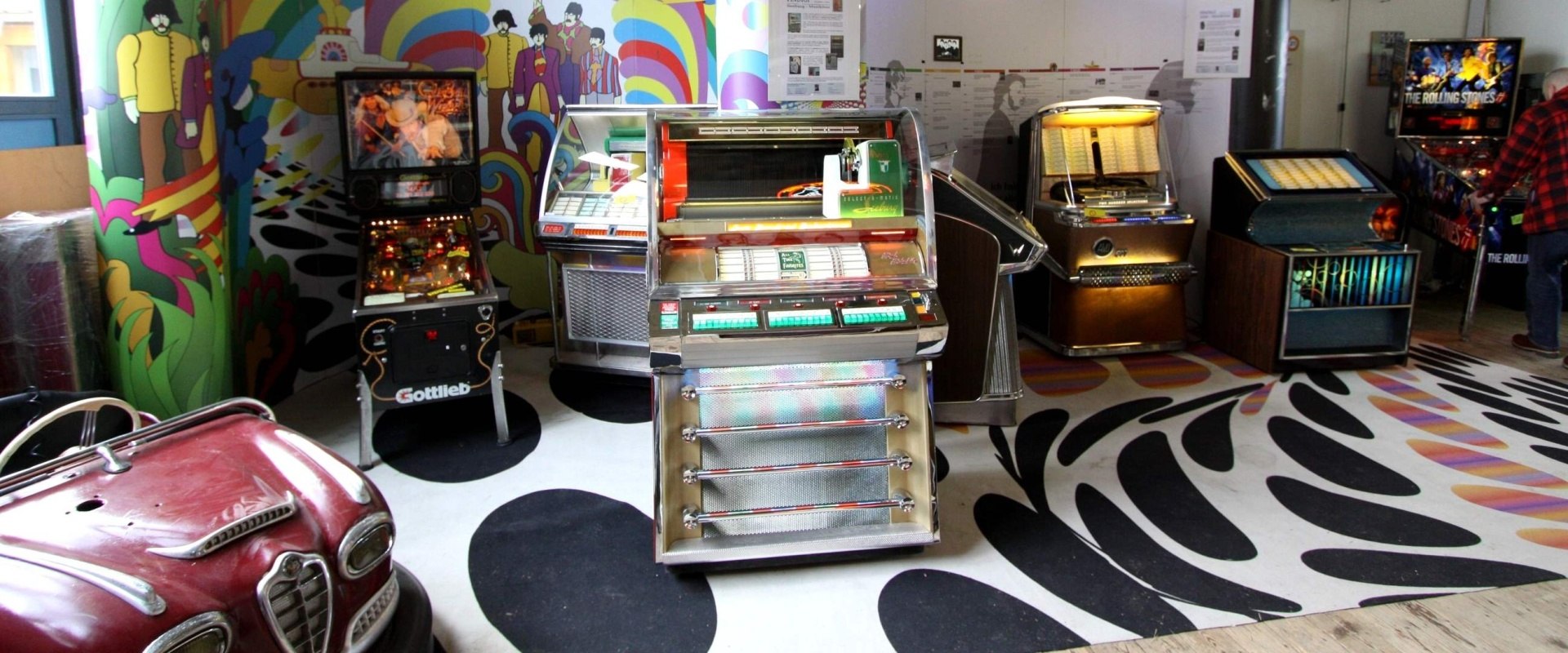The big names
BALLY – pinball machine
From 1930, Ray Moloney worked in the Midwest for GOTTLIEB as area representative. He was co-owner of the Lion Manufacturing Company, which could not satisfy a huge demand for GOTTLIEB’s baffle ball. In 1932 he got the necessary starting capital together and developed Ballyho.
Ballyho was an eye-catcher. The rainbow-colored playing field magically attracted people and sold it for $ 16,000 75,000 times. To further the success of Ballyho, Moloney subsequently founded the Bally Manufacturing Company. Before 1940 came the device “Bumper” on the market, which had metal towers on the playing surface, which made a contact and thus the ball could score points. In the 50’s, BALLY was represented with only one device. “Balls are Poping” from 1956 a 2-man pinball machine, which indicated the score by lit up elements of the transparent glass (Backglass). It was not until 1963 BALLY introduced the next pinball machine.
Under legislation in 1951, 1-ball devices and payout machines were banned and replaced with bingo pinballs.
It became innovative again in the 60’s with the Open Gate feature and the invention of designer TedZale, who created the Zipper pinball machine. Capersville was the first BALLY hit after re-entering the pinball business. As a bonus there was multiball. With that, Capersville beat all former pinball records, because it was produced 5,000 times, instead of the usual 2,000 pieces.
With the primeval motif at the Four Million B.C. BALLY had the next hit and this was continued with the great Fire Ball, which in 1972 had a built-in rotating disc in the field, so that the ball was thrown in different directions. The Fire Ball II came in 1981 on the market and was already an electronic pinball, as well as the Fire Ball Classic, which came in 1985 on the market. The Fire Ball Classic was designed by Doug Watson.
Pop music made its debut and BALLY added more accents with Wizzard (rock opera Tommy) on the disc was WHO singers Roger Daltrey and Ann-Margret. The lead actor Elton John was implemented with the Captain Fantastic, which had a peak circulation of 16,155 pieces. This was the era of electromechanical pinball machines and the electronic pinball machines came. BALLY was the market leader in electronic pinball, the first to produce Freedom and Night Rider.
The eight ball was normal from the pitch, but had a memory (memory and this by a player). The famous BALLY designers were Dave Christensen, Ted Zale and Christian Marche.
GOTTLIEB pinball machine
David GOTTLIEB entered the ball business in 1930. He bought the rights to Bingo from the Bingo Novelleti Manufacturing Company. His first hit was Baffle Ball, which sold more than 50,000 copies in 1931 at a price of $ 17.50.
Without pinball there was still an incentive to play a game for 1 cent 7 balls in times of deepest depression. Gottlieb was also one of the first to sell his games through selected area representatives with defined sales areas.
The GOTTLIEB engineer Harry Mabs more or less accidentally invented the movable pinball machines. In the tangle he accidentally brought together 2 bare ends and the bumper was activated without ball contacts. This was the solution – the implementation a breeze.
In October 1947 Hompty Dumpty appeared with an arrangement of 3 Flipperpaaren on the field. Over 6,500 pieces have already been produced. From 1950, Gottlieb probably would have been the number 1 in the industry and Gottlieb also made for the first attractions in the field – Animated Backglasses.
GOTTLIEB was also the first to use counters instead of lighting up numbers for the scores. From 1960 Gottlieb brought out for the first time the “Add-a-Ball” system, with which one could win additional free balls.
Famous Gottlieb machines were there flipper parade, pinball fair, pinball clown and pinball cowboy. The Spinner first appeared in the 1963 Gottlieb “Swing Along” device.
Snow Derby came on the market in 1970 and here for the first time a bonus ladder was used, with which one could collect points.
In 1976 there was already the “Spirit of 76”, which came on the market in recognition of the 200th anniversary of the United States.
In 1984, the slide went so far that one at Columbia Pictures then owner of GOTTLIEB – decided to close the game department and thus GOTTLIEB.
Gil Pollak, one of the GOTTLIEB employees, brought investors together and brought the old crew together for a new Pinball production called “Premiere Technologies”.
WILLIAMS – Flipper
The young Californian Harry WILLIAMS entered the Pinball business before 1930.
He was one of the first to install electricity in the form of 6V batteries in the toy boxes, illuminating certain parts of the field.
1933 brought out the “contact” and in this device was on the playing surface of one of the holes provided with a kicker, which catapulted with the help of coils with electromagnet and iron core, the ball back into the field.
Harry WILLIAMS also invented the tilt mechanism. The dreaded Tiltpendel hung in the center of a metal ring and closed by violent shaking a contact, which blocked the game.
In 1946 he founded the Williams Manufacturing Coroporation.
In 1955, the first 4-man player from WILLIAMS came out with “Race the Clock”.
In 1960, Williams first set the drop targets (retractable targets).
In the 70’s the Up Post by WILLIAMS and for the first time the Hayburners II the 7.5 cm longer pinball arms were used.
As well as all other pinball makers, Williams then used famous designers like Steve Kordek and Christian Marshe or George Molendin.
In 1976, the Space Mission came as a tribute to the successful coupling maneuvers of an American and a Soviet space shuttle on the market.
In 1979 he set new sound accents with the Flipper Flash.
10 years later in 1989, the flippers had already built in voice chips, eg the Jokerz. In 2001, Williams closed the pinball production.

